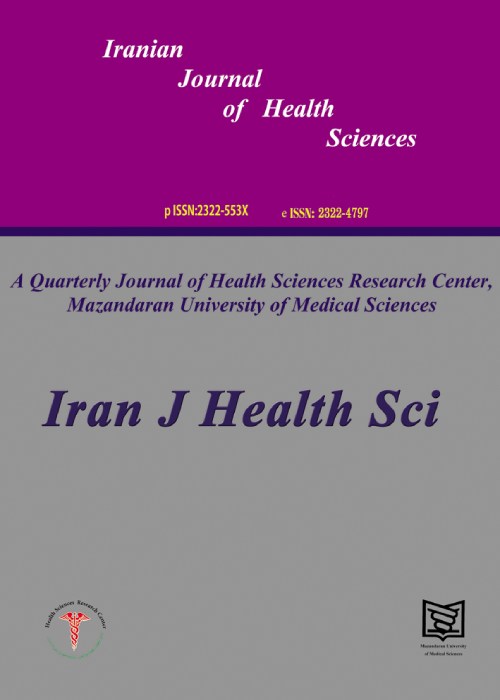فهرست مطالب
Iranian Journal of Health Sciences
Volume:8 Issue: 1, Winter 2020
- تاریخ انتشار: 1399/01/11
- تعداد عناوین: 4
-
-
Pages 1-10Background and aims
Cement production processes are associated with different hazards, such as health and safety hazards and environmental pollution. The current study was conducted to evaluate and determine the safety, health, and environmental risks of using FMEA and AHP techniques in the cement factories while providing certain suggestions for controlling them.
MethodsThe study was conducted as a case in one cement factory in 2019. The checklists for FMEA and AHP techniques were filled out by the evaluation team. The risks were identified and prioritized. Controlled approaches were suggested for the identified risks.
ResultsIn this study, 101 risk cases were evaluated and categorized in various units of the factory, such as manufacturing and service units. The results of FMEA technique showed that crushing, crushing monitoring, milling, filtration, and pre-heater sections had the highest degree of health and safety risks. The results of AHP technique also showed that the environmental pollution caused by the removal of electro filter from the circuit, electro fan burning caused by over current, the failure of the equipment and process, and the defect in the filtration system were all prioritized.
ConclusionThrough taking technical-engineering measures, adopting comprehensive HSE management solutions, such as changes in the work process, making replacements in parts and used machinery, installing recyclable systems, repairing and maintaining the system of air pollution protection, installing a warning and responsive system, mechanizing activities, shielding, implementing instructions and regular curriculum can greatly reduce the risk level.
Keywords: health, safety, environment, FMEA, AHP -
Pages 11-18Background and Purpose
Poisoning with pesticides, drugs, and chemicals is one of the most important health problems in the world, causing a varying mortality rate in different regions. Easy access to a variety of drugs and poisons has caused some people to be hurt by using such things. The aim of this study was to evaluate the poisoning and mortality rate by using poisons, drugs, and chemicals in Meshkinshahr, a city in Ardabil Province.
Materials and MethodsThis descriptive and analytical cross-sectional study was conducted in Meshkinshahr Hospital from 2017 until the end of 2018. All information of people who were poisoned with pesticides, drugs, and chemicals was extracted from hospital case, and then was analyzed by SPSS 23.
ResultsTotally, 453 cases were referred to hospital with 173 (38.20 %) male and 280 (61.80 %) female. 73% of the cases were poisoned by using medications and drugs , 18% by using other chemicals and 9% by poisons and pesticides. The mortality rate was 4%, with 70% due to exposure to pesticides and toxics, and 60% pertaining to deliberate suicide.
ConclusionAccording to the results of this study, most of the poisoning cases occurred as a result of using drugs; however, more than 70% of mortality was due to pesticides which indicated the toxicity of the pesticides. Also, the findings emphasized that the knowledge of target people is low.
Keywords: Poisoning, Deaths, Pesticides, Drugs, Chemicals, Ardabil -
Pages 19-28Background and purpose
There is a return to rationality and ethics in the approach of current world. After several eras, humanity comes to consider rationality and ethics in addressing its physical and moral needs. From this point of view, ethics could be considered as a center of evolution in the future. This approach mainly influences those practices that are in the lead in serving people. Therefore, in this study, the aim was to investigate stakeholders’ points of view about Phenomenological ethics and professional behavior of auxiliary health workers at first level of health services delivery.
Materials and methodsThis qualitative study was conducted through semi-structural interview in 2017. The study population included 9 principals of staff technical unit, 5 physicians in charge of rural comprehensive health centers, and 12 auxiliary health workers of affiliated health houses who were selected purposefully. After conducting the interviews, the data was transferred to paper and analyzed using content analysis with emphasis on core and non-core factors that influence behavior and professional ethics of auxiliary health workers from inter-organization stakeholders’ viewpoints.
FindingsThe results of this study included two general domains of the main elements (ethical and behavioral), and a total of 12 sub-areas of each of the two main elements, including 3 sub-domains that comprised the moral criterion: (secrecy, censorship, good behavior), as well as three behavioral criteria (accountability, expressive power, motivation), and ultimately 107 basic categories from 3 perspectives, which were all selected by institutional stakeholders: technical units, physicians of comprehensive health centers, as well as healthcare providers.
ConclusionThe expressed experiences have shown that the issues surrounding the ethics and behavior of auxiliary health workers who are providing health services at the front line of health system, is inevitable in order to intervene in improving and promoting the quality of morality and behavior of this group of health professionals.
Keywords: Professional ethics, professional behavior, front line services, qualitative study


